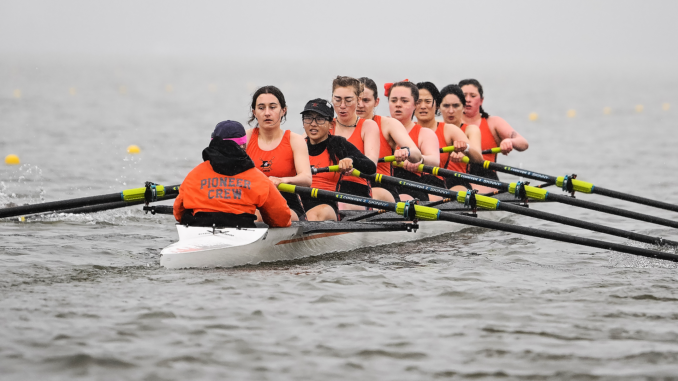
Crew, also known as rowing, is a popular sport at Lewis & Clark, especially within the last couple of years. Both men and women’s crew teams tend to be very successful in regattas, especially with our women’s team, or the “Dub-Squad,” who competed at the national level last year. But what makes rowing such a draw for students?
Nora Barnard ’25 has been rowing for two years at LC, which was also the start of her rowing career as a whole.
“I had athletic experience but no rowing experience. I walked on in my freshman year and started fresh,” Barnard said. “It was a pretty small team when I walked on, but last year we had a ton of new novices. The novice class last year really fell in love with it and stuck with it through the hard training.”
Jackson Sheire ’26 was also a walk-on for the team, but he had been rowing for years prior.
“The only reason I got into it was because my mom was like ‘Hey, you might like this’ and then I did, and I’ve been doing it ever since,” Sheire said. “Being on the water is such a nice experience. It’s very serene and surreal. Oftentimes, even though there are other people on the boat, at the same time it’s just you and the boat. A little bit of your brain shuts off.”
According to both Sheire and Barnard, walking on to the rowing team with little to no experience was made easy and fun by the energy of the team.
“One really nice thing about rowing is that most of the time it’s really good, but sometimes it can be really shitty. But having a shitty experience with a bunch of people, all doing it at the same time, builds a good amount of camaraderie,” Sheire said. “Everyone is very welcoming and it’s a very nice thing to walk into because people want you to be there.”
While walking on may be a breeze, you have your work cut out for you athletically. On days when they have practice, the team does weight training in the mornings, including “erging” (using an ergometer, or rowing machine, on dry land), before getting on the water for a couple of hours.
“(The technique) seems simple but doing it right is a lot harder than it seems. You can do the movement, and do it good enough to row, but to do it well you have to be doing it for a while,” Sheire said. “It’s just a lot of little things to look out for, and you become really good when you can do all of those little things without thinking about it. To get good, you have to focus on one thing at a time. It takes a good amount of thinking.”
There are several positions in a single boat. There are eight synced rowers with one person in the “stroke seat” in front, setting the rhythm. In addition, there is a coxswain, who steers the boat as well as calls instructions over a mic system to the entire vessel.
To go to nationals again, the women’s team would have to have their boats win in the 1v8, an eight-person boat comprised of the best rowers and 2v8, (the second best rowers) competitions.
“Right now, our biggest rival is Puget Sound. They have some fast boats. Our coach is doing this thing called ‘seat racing’ where we do a bunch of races and he takes times to see who’s the fastest in order to find the fastest lineup,” Barnard said. “We’re trying to finalize the lineup for conference because we want to go again, but we have competition.”
If the women’s team continues to do as well as they did in pre-season, they may very well make it to nationals again. A large portion of the team’s junior rowers are going abroad next year, which leaves open spots available for interested novices. Keep an eye out for this season’s results, and be sure to attend regattas to support LC rowers!
Subscribe to the Mossy Log Newsletter
Stay up to date with the goings-on at Lewis & Clark! Get the top stories or your favorite section delivered to your inbox whenever we release a new issue.

Leave a Reply